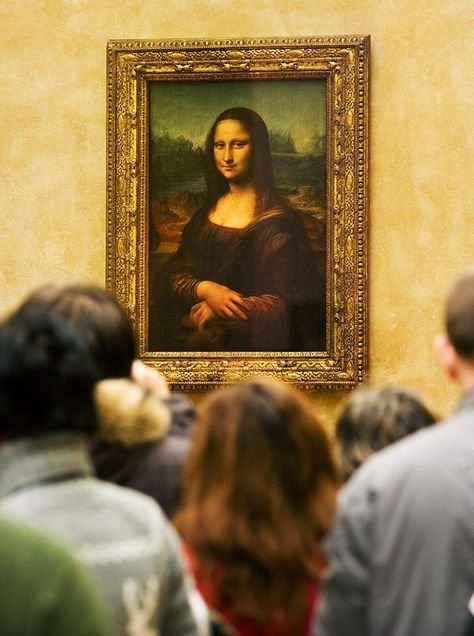Leonardo da Vinci’s Mona Lisa stands as a monumental symbol in the world of art, renowned not just for its aesthetic brilliance but for its rich history and enduring mystique. This iconic painting, housed in the Louvre Museum, continues to captivate audiences with its enigmatic charm and historical significance. In this detailed exploration, we uncover fascinating aspects of the Mona Lisa, including its origin, the identity of the sitter, and the factors contributing to its legendary status.
The Origins of the Art
The Mona Lisa, painted by Leonardo da Vinci, was created between 1503 and 1506 during the Italian Renaissance. Da Vinci, a master artist of the period, was commissioned to paint this portrait by the wealthy Florentine merchant Francesco del Giocondo. The painting’s original purpose was to celebrate the birth of the Giocondos’ second child, Andrea. This commission from the Medici family, prominent patrons of the arts, marks the beginning of the Mona Lisa’s journey into the realm of iconic art.

The True Identity of the Art
The woman depicted in the Mona Lisa is widely recognized as Lisa del Giocondo, a member of the prominent Gherardini family from Florence. Lisa, the wife of Francesco del Giocondo, was portrayed in this famous painting as part of a commission to mark the birth of their child. Despite numerous theories and speculations about the identity of the woman in the portrait, historical research and documentation have confirmed that Lisa del Giocondo is indeed the subject of da Vinci’s masterpiece.

What Makes the Art a Masterpiece?
The Mona Lisa is celebrated for several compelling reasons, each contributing to its status as a timeless masterpiece:
-
The Enigmatic Smile
One of the most intriguing aspects of the Mona Lisa is her mysterious smile. This subtle expression has sparked endless debate among art critics and historians. The smile appears to change when viewed from different angles, adding to the painting’s allure and the enigma surrounding the subject’s true emotions.
-
Leonardo da Vinci’s Innovative Techniques
Leonardo da Vinci’s artistic genius is evident in the Mona Lisa through his use of sophisticated techniques. The painting showcases his mastery of sfumato, a technique that creates a soft transition between colors and tones, contributing to the lifelike quality of the portrait. Da Vinci’s skillful use of light and shadow adds depth and realism, making the Mona Lisa a prime example of Renaissance art.
- Cultural and Historical Significance
Beyond its artistic value, the Mona Lisa represents a significant cultural and historical artifact. It encapsulates the spirit of the Renaissance era and exemplifies da Vinci’s innovative approach to art. The painting’s widespread fame and enduring appeal underscore its importance in art history.
- The Magic and Mystique
The Mona Lisa’s allure is further heightened by its mystical qualities. The combination of her ambiguous expression, da Vinci’s pioneering techniques, and the painting’s storied history creates a sense of wonder and intrigue that has fascinated audiences for centuries. This sense of magic contributes to the Mona Lisa’s status as one of the most celebrated artworks of all time.
The Theft and Damage of the Art
The Mona Lisa has experienced several significant events in its history, including theft and damage:
- The 1911 Theft
One of the most notorious incidents involving the Mona Lisa occurred in 1911 when the painting was stolen from the Louvre Museum by Vincenzo Peruggia, an Italian handyman. Peruggia hid the painting for two years before attempting to sell it in Italy. The theft generated global media attention and further cemented the Mona Lisa’s status as a cultural icon.
- Color Loss and Damage
Over time, the Mona Lisa has suffered from issues such as color loss and damage. Factors such as age, inadequate cleaning methods, and environmental conditions have contributed to the deterioration of the painting’s surface. Restoration efforts have aimed to preserve the painting’s integrity while addressing these concerns.
- Visitor Pressure and Preservation
The immense popularity of the Mona Lisa means that it faces constant exposure to large numbers of visitors. This high volume of foot traffic presents challenges for its preservation. To mitigate these issues, the Louvre Museum has implemented rigorous protective measures to shield the painting from potential harm caused by light, humidity, and physical contact.
The Conservation Process of Art
The conservation of the Mona Lisa involves several critical measures to ensure its longevity:
- Controlled Environment
The Louvre Museum maintains a meticulously controlled environment for the Mona Lisa, with regulated humidity and temperature levels. This controlled environment helps prevent sudden changes that could damage the painting.
- Lighting
The Mona Lisa is displayed in a dimly lit room to minimize light exposure. Prolonged exposure to strong light can cause fading and deterioration, so the museum uses specialized lighting to protect the artwork.
- Material Protection
The painting is safeguarded by a reflective and UV-resistant glass case, which protects it from harmful sunlight and environmental pollutants. This protective layer helps preserve the artwork’s colors and details.
- Regular Maintenance
The museum conducts regular inspections and maintenance to address any issues that may arise, such as humidity, mold, or environmental fluctuations. These ongoing efforts are crucial for maintaining the painting’s condition.
- Security Measures
Stringent security measures are in place to protect the Mona Lisa from theft, vandalism, or accidental damage. The painting is monitored by security personnel and surveillance systems to ensure its safety.
The Global Reputation and Value of the Art


The Mona Lisa’s reputation and value extend far beyond its artistic merit:
- Global Fame: As one of the most recognizable artworks in the world, the Mona Lisa attracts millions of visitors to the Louvre Museum each year. Its global fame contributes to its status as a cultural and artistic icon.
- Cultural Impact: The Mona Lisa has become a symbol of cultural significance, appearing in various forms of media, including advertisements, pop culture references, and art reproductions. Its influence is evident across different cultural contexts.
- Spiritual Value: The Mona Lisa holds immense spiritual value for art enthusiasts, who are drawn to its enigmatic expression and the sense of mystery it evokes. The painting’s allure lies in its ability to provoke deep emotional responses and reflections.
- Historical Significance: The Mona Lisa represents a pivotal moment in art history, reflecting the Renaissance era’s artistic advancements and da Vinci’s innovative techniques. It serves as a historical artifact that encapsulates the achievements of this period.
- Economic Value: While the Mona Lisa’s exact economic value is difficult to quantify, it is considered one of the most valuable artworks in existence. Its significance goes beyond financial metrics, encompassing its cultural, historical, and spiritual worth.
In conclusion, the Mona Lisa is much more than a painting; it is a profound and multifaceted masterpiece that continues to inspire and captivate audiences around the world. Its artistry, historical significance, and cultural impact ensure its place as a timeless symbol in the realm of art.
